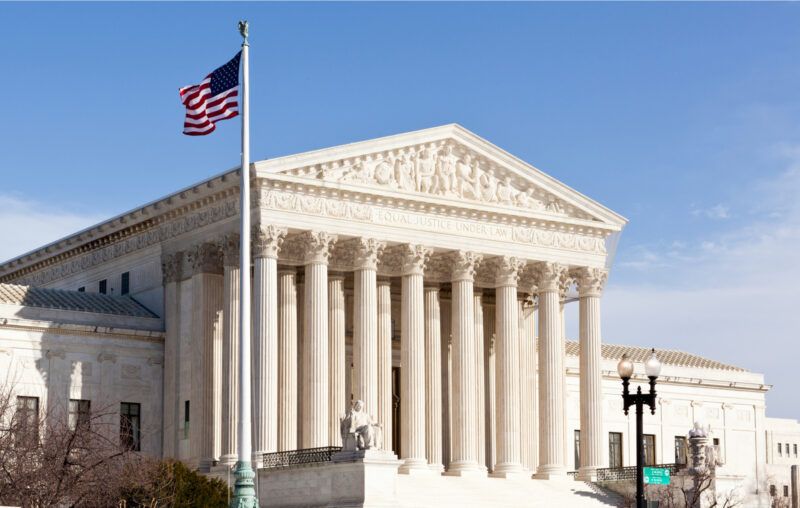Stop Bringing Politics Into the Supreme Court

With the Supreme Court squarely in the crosshairs of American politics, especially with the nomination of Amy Coney Barrett, it would be best if as many people as possible actually understood how the Court works. Although an informed discussion is always good for any political topic, it is especially important for the Supreme Court because it is one of the three pillars that support the foundation of our country. Reforming the Court in any meaningful way will have ramifications that will affect every aspect of the American government now and forever. Furthermore, the Supreme Court and the Judicial Branch more generally are fundamentally different from the politics that most people are familiar with.
Today politicians are riling up their bases to mobilize over judicial nominations and consider reforms such as expanding the number of seats on the Court or imposing term limits. The ongoing rhetoric surrounding the Court falls worryingly short of how the Supreme Court actually functions and threatens to poison this essential branch of government with toxic partisanship.
The Supreme Court in Context
The Constitution lays out three essential branches of government that separate power vertically and horizontally with the main intention of preserving individual liberty while forwarding good government. The ongoing politicization of the Supreme Court, particularly from the Progressive side of the aisle, but often from the Conservatives as well, threatens to blur the separation of powers that exists. The Court is not a decision-making branch of government and proposals to pack the Court or paint judges as threats to various political agendas threaten to corrode the purpose of this essential branch of government.
The Legislative and Executive branches are political offices. Congress comprises the Legislative Branch, which is the primary lawmaking body that is democratically elected on a representational basis. It is supposed to be creative, chaotic, spontaneous. This is where new ideas are debated, budgets are drawn up, and laws are created. Members of the legislature can, relatively speaking, be as partisan or as extreme as they wish. They can come from all sorts of backgrounds, from career politicians to bartenders. If you are unsatisfied with their performance, they are up for election every two years for the House of Representatives and six years for the Senate.
The Executive Branch is a mix of politics and bureaucracy. It includes the President and the administrative agencies that have some sway over the lawmaking process but also have a responsibility to execute the laws created by Congress. The President is up for election every four years and the leaders of federal agencies are political appointees who provide a level of bureaucratic expertise.
The Judicial Branch is the third branch of government and the Supreme Court is the court of last resort. The Court has no authority to write original laws, allocate money, or even enforce its ruling with force. Its sole responsibility is to interpret the Constitution, act as the final word on legal proceedings, and rule on the constitutionality of the actions of the other branches. The judges who sit on the Court are typically career public servants with a deep appreciation for the law. Supreme Court justices have lifetime tenure among many other anti-democratic protections to shield them from the politics of the two other branches. These essential protections exist to ensure the independent rulings of judges, as politicians would love to remove this check on their power.
The Supreme Court is Not A Political Branch
One of the common accusations that have been levied at recent judges, namely Justices Gorsuch and Kavanaugh, and now Judge Barrett, is that they are a threat to various Progressive agendas. They are painted as existential threats to abortion rights, healthcare, gay rights, and environmental regulations. These are not only baseless and slanderous accusations, they also fail to realize how the US government works. However, it is more likely that such statements are not made in ignorance but with politics very much in mind. Such an attempt to politicize the court in order to advance a political agenda is not unheard of; Franklin Delano Roosevelt, for example, in his effort to exert unprecedented power by packing the Supreme Court.
Justices are aggressively nonpartisan compared to their counterparts in the two other branches. As a panel of nine justices, those on the court cannot afford to make enemies nor is the work that they do particularly political. They have civil discussions over the texts of the law, the facts of the case, and the meaning of the Constitution. Although there are plenty of disparate opinions on the court, they are grounded by precedent, the law, and judicial philosophy. It is more akin to a deep intellectual discussion rather than a political brawl. It is not uncommon for judges to persuade one another during these intimate and genuine discussions. That is why “conservative and liberal” judges tend to vote in all sorts of combinations. According to a report published by Quartz
“The US Supreme Court last week wrapped up the 2018 term, having decided on the merits of 72 cases. These matters yielded many opinions, revealed surprising alliances, and proved you never know how the justices will vote.”
Justice Kavanaugh for example, who the Democrats viciously painted as an anti-abortion ideologue, sided with liberal justices on an abortion-related case. Justice Gorsuch was painted as a threat to LGBTQ rights; however, he recently sided with liberal justices and made an originalist case for extending the 1964 Civil Rights Act protections to the LGBTQ community.
Judge Amy Coney Barrett will likely be the same. She has a history of service as a federal judge and the American Bar Association gave her a “Well Qualified” rating. She has made countless statements clarifying that her personal views will not influence her judgment and that she will interpret the Constitution as written, as judges must do. There is nothing to suggest that she is a sure win for those who wish to restrict abortion or those who wish to repeal the Affordable Care Act as pundits from both sides would suggest.
Although one might disagree with Judge Barrett or any other justice on the court, that is fundamentally a question of judicial interpretation, not personal politics. Furthermore, all decisions are made in the context of the case at hand. A judge cannot make accurate predictions on how they would rule until the facts are presented.
The Consequences of a Supreme Court Decision
One of the main talking points offered by both sides is that a particular judge on the Supreme Court will be a victory for a political agenda. This is highly misleading. In the context of policy making, the court is simply a check on political power as its main duty is to enforce the Constitution. If, for example, a law or regulation is struck down, that is not because the Court is hostile to a policy. That policy is just unconstitutional in the eyes of the Court. Congress and the Executive Branch are more than free to do anything they want, provided it is within the Constitutional bounds set by the Court.
The topic of abortion is an example of this dynamic. Roe v. Wade is a massive point of contention that has come up in all three of the most recent Supreme Court confirmation hearings. Roe v. Wade guarantees a constitutional right to an abortion, so both sides have peddled a fantasy that appointing Judge Barrett will effectively end abortion.
This, however, is an overly simplistic and problematic narrative about the power of the Court. Disregarding the fact that there are few justices on the Court who would likely vote to overturn Roe v. Wade, if Judge Barrett votes to overturn it will be because she finds technical flaws in the way it was decided. Not because she personally dislikes abortion.
More importantly, if Roe v. Wade were to be overturned that would not end the practice of abortion in America. All that would do is end the federally guaranteed right to an abortion. Abortion would then be debated in Congress or become a state issue where the citizens of each state would decide through the political process to what extent abortion would be permitted. The burden of advocating for or against abortion would then be placed on political actors and the democratic process.
With a few exceptions, the rulings of the Supreme Court have little direct contribution to various political agendas. They just open or close the avenues for the political process. If that were not the case, then the Court would effectively be an unelected oligarchy. However, that is clearly not the case. It is an essential check on the powers of government and the steward of the Constitution. The burden of advancing various political goals falls not on the Court but political actors and activists.
“Conservative and Liberal” Justices
Although the terms Conservative and Liberal may be used to describe justices, they are mostly an oversimplification of judicial philosophy. Although they may at times conveniently align with right or left-wing policy agendas, judges rule based on a completely different dichotomy of thought.
Judges who make up the Supreme Court’s “Conservative Majority” are what are known as Originalist. AP News explains that
“Originalism is a term coined in the 1980s to describe a judicial philosophy focusing on the text of the Constitution and the Founding Fathers’ intentions in resolving legal disputes. Originalists argue that new legislation, rather than new interpretation of the Constitution, is the best way to bring about social change and safeguard minority rights.”
This is an extremely principled view of the judiciary that intends to apply the original public meaning of a text. It does not matter what one’s views of what ought to be are; what matters is what the original framers of the law intended it to mean.
For example, the late Justice Antonin Scalia remarked that the death penalty is constitutional because the framers of the Constitution created the 8th Amendment, the right against cruel and unusual punishment, with the death penalty in mind. It doesn’t matter what he thought about the death penalty; the fact of the matter is that it was clear that the 8th Amendment was written with the intention that the death penalty would be a suitable form of punishment. If one wishes to abolish the death penalty, they can vote to abolish it through the political system. However, it is not the role of the Court to do so.
In contrast to originalism are proponents of the “living constitution” which is the dominant philosophy of “liberal” justices. AP News writes
“This judicial philosophy considers the Constitution to be a living document, able to encompass society’s changing, evolving values.”
Justice Breyer makes the case for this philosophy when he explains that sometimes not all the answers are held in the text of the law or the context of its creation. Furthermore, societies evolve and the Constitution along with its interpreters should evolve with it. Many laws were written when minorities of all types weren’t considered full citizens; should they be interpreted as such?
Both of these judicial philosophies take countless hours of thought and discussion to fully wield. Furthermore, as demonstrated by the collegial and collaborative nature of the Court, they are not partisan or binding. This is in drastic contrast to the prevailing way politics is conducted outside the court.
Although one’s first reaction is to wish all politics should be like the Supreme Court, these differences are actually productive. In the political process we need spontaneous and passionate advocacy or else we wouldn’t get any new ideas. You cannot come up with new laws and programs or have any sense of democracy if you based everything off the Constitution.
However, such passion and idealism should be left at the door in the Supreme Court, where disinterested and technical discussions are the only appropriate way to adjudicate justice.
Why Is This Important
It is not often that the Supreme Court is the target of political campaigns. The Court is usually a boring and highly technical topic that exemplifies civility, service, and intelligence. That is what makes it so dangerous that it is being framed in a political light, something worthy of being protested and berated. Even more worrisome is the threat posed by hopeful Court reformers who propose expanding the number of seats on the Court in order to protect their political agendas.
The confirmation hearings of the last three nominees have been the subject of national scrutiny and excitement. This fundamentally misses the mark on what the Court is supposed to be and suggests an ominous politicization of the Court that could wreck the country. However, there may be some hope in this perilous situation. That is that more Americans will be educated about the true purpose and the stellar civic function of the Supreme Court. A shining sanctuary of principle, civility, justice, and intelligence in a country that seems to be losing its way.










